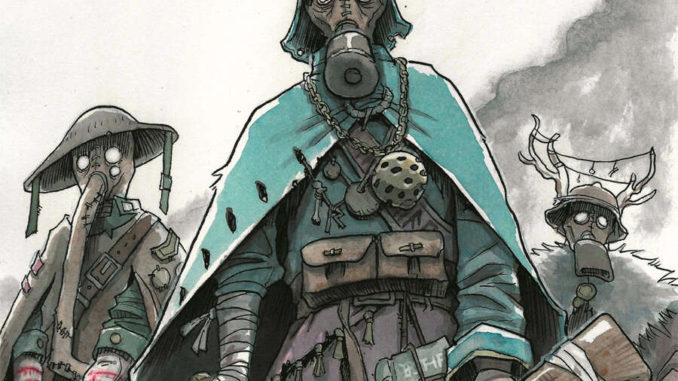
Normally, I review RPG adaptations that are a straightforward conversion from one media to another; however, for this one, Never Going Home, I utilized an indulgent definition of adaptation. Never Going Home is a tabletop RPG from Wet Ink Games that adapts two things, Weird World War One and Charles Ferguson-Avery’s art book, but neither of them literally. Instead, each serves as the inspiration (and art) for the game.
I know, I know, who doesn’t know what that is? If you thought that after reading the section title, I’m wasting your time with this paragraph and I’d recommend skipping to the next section. But, for those who don’t know about the Eastern Front, the Zimmerman Telegram, and Verdun, let’s do the quick overview. In 1914, a Serbian assassinated an Astro-Hungarian nobleman (a nationality that no longer exists in a unified form). The fallout from that would be the excuse to kill upwards of 20,000,000 souls by the end of 1918. The tactics were machine guns, trenches, chemical weapons, and the least competent generals in history. The results of the war were the catalyst for another 100,000,000 to 200,000,000 dead (depending on how wide a net you cast) through the changes it brought to the course of history. This war to end all wars set the table for the creation of the Union of Soviet Socialist Republics, Japan’s expanded invasion of continental Asia, the rise of Adolf Hitler, the end of European domination of the globe, the current situations in the Middle East, and so much more. In the cosmic scheme, the nation that the nobleman hailed from lost the war, the winners went bankrupt as did the whole world, and an entire generation of European males, as well as hundreds of thousands from their colonies, never came home.
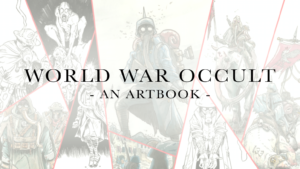 Who is Charles Ferguson-Avery?
Who is Charles Ferguson-Avery?
Artist of the webcomic, BlackMarch, and the artist of World War Occult, the art book that served as the inspiration and art for Never Going Home. Charles also developed his own aRtPG project with Into the Wyrd and Wild, a book that is largely system neutral with d20 OSR leanings.
What is Weird World War One?
It’s a smaller subgenre akin to Victorian Horror with elements of terror set during WWI. Much of what makes it interesting can be read in Never Going Home and in Pinnacle Entertainment Group’s Savage Worlds line of Weird Wars. As a lightly explored genre, there is ground for both Charles Ferguson-Avery’s World War Occult art book and NGH to explore the horrors of the first World War juxtaposed with the horrors of HP Lovecraft’s nightmares.
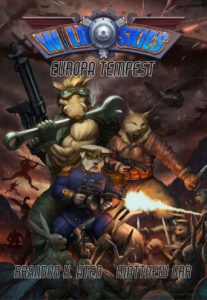 How Did Never Going Home Come About?
How Did Never Going Home Come About?
I asked Brandon K. Aten of Wet Ink Games and Charles Ferguson-Avery how NGH evolved from WWO. Brandon shared his memories:
“My co-creator, Matthew [Orr], and I had been following Charles since I met him at Gen Con a few years ago, and we had him do some other work for one of our digital Wild Skies releases. We were always pleased with his ability to take direction and really buy into the art assignments. He started posting some really crazy/amazing art, which would eventually become his World War Occult project, and Matt and I both reached out to the other to make sure we were seeing it. We knew we wanted to do something with it, and almost immediately reached out to Charles to gauge interest.”
Charles Ferguson-Avery recalls it similarly:
“That was ALL Brandon Aten and Matt Orr. I really just made the World War Occult art book to just see if I could do it. I had some plans for maybe doing a comic with it or maybe doing another collection of drawings and paintings, but nothing NEARLY as ambitious as what it is now. They came up with the idea, we talked it through, I said something along the lines of “Yeah, that sounds cool,” did some contract stuff, and then, boom, a year later and I’m watching all of the core rule books sell out at Gen Con.”
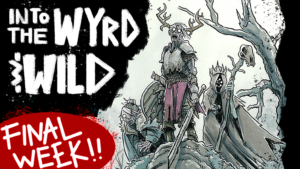 Going further, I asked Brandon and Matthew how Charles’ work inspired them. Brandon gave this thought:
Going further, I asked Brandon and Matthew how Charles’ work inspired them. Brandon gave this thought:
“Honestly, my wife is a HUGE World War One scholar and she had recently gotten me interested in the subject matter as well. We would regularly talk about how horrible to war was. I started looking into other games, like the card game The Grizzled or the Valiant Hearts video game. Both are among my favorites in their genres and translate the nature of the conflict in gritty and unexpected ways. When I first saw and shared Charles’ art, I immediately felt the same kind of gravitas and knew that with the right ruleset and creative team, we could be a part of making something really special.”
Matthew Orr remembers this:
“World War Occult started as Charles’ Inktober project; everyday a new image. His skill at visual storytelling was clear. First were the images of soldiers; on patrol in ruined cities, marching uphill, slumped in the dirt. Then came an image of a soldier all in shadow with flies around their head. Two other soldiers are literally looking over their shoulders at the one who is rotting alive. Then came the images of monsters and magic. Tentacles and gaping mouths and soldiers with runes cut into their arms. The art told a story of everything going from bad to worse. I immediately said to Brandon, and then we said to Charles, there’s a great story here, let’s do something more with these images. Let’s set a roleplaying game in this horrible world.”
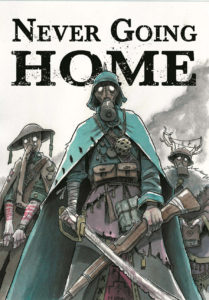 Who is Wet Ink Games and What is the +One System?
Who is Wet Ink Games and What is the +One System?
Wet Ink Games is home to Wild Skies, an anthropomorphic dieselpunk RPG, Never Going Home, and, soon, Tenebria (on Kickstarter now). They developed the +One system, which Matthew Orr describes in relation to Never Going Home:
“+One works for NGH because it helps make everything feel like a struggle. Players need 3 or 4 successes on average but each [d6] is only a success 33% of the time (5 or 6). The characters have to make an effort with their raw attributes to accomplish almost anything. Players start with just few skills and the game can be lethal if the Narrator wants it that way. Then you add in the cards and you have another layer of making an effort where nothing is taken for granted. In play all of this helps create tension about if the characters can even survive let alone accomplish anything.”
Charles added this:
“It’s much more narrative driven. Rather than rely on hard stats that would turn it more towards a war game or D&D-style game (admittedly, both genres I love dearly), it focuses on these moment-to-moment stories that happen when players push their characters to the limit or fail to overcome a particular test.”
Getting into the Never Going Home accessories, I asked how the system, which incorporates dice and cards, the same sources of entertainment available in the trenches, inspired the creators. Matthew volunteered this:
“Just in the final look of the cards and dice. We have cards that look dirty and dice which look like they were custom made. They are supposed to feel like they could have been made by the characters in the trenches. This applies to the character folio and the interior of all the books which have the same aged paper with notes and sketches pasted in. The whole game is supposed to look like it fits the theme.”
Brandon added:
“Like Matt mentioned, we wanted the books and the ancillary items to really have the feel of the theme. The Character Journal, for example was made 5”x8” specifically so that players could put it in a refillable leather journal sleeve if they really wanted to. The printed materials were laid out in such a manner as to appear as artifacts from the word. As for the dice and cards, we mostly wanted the system to be accessible to anyone with standard dice and a deck of playing cards, but we really leaned into the design during the process.”
Charles drew a different inspiration:
“Yes, but in a much different way. Since I was mainly focused on the art, I started to play around with the idea of the soldiers’ tools and game pieces being modified into occult implements. Bullet necklaces, petrified relics, ritual combat knives, you see it peeking through in the character designs throughout the book!”
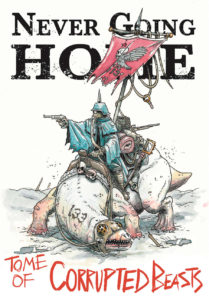 What Does Charles Ferguson-Avery Think of Never Going Home?
What Does Charles Ferguson-Avery Think of Never Going Home?
“I love it. Personally, I wish I had the time to do more art for it, but my schedule is constantly packed. As for the mechanics, I couldn’t be happier. When we were in the initial talks of putting it together, I made it clear that this was not meant to be a “glamorous” game about war and conquest. Instead, it should be a game about the quiet and selfless heroics that take place between survivors and people, not as soldiers fighting for glory or country. They nailed it.”
Should I Play Never Going Home?
World War One is a terrible period of world history that led to apocalyptic levels of carnage and leaving the survivors so scarred, World War Two was an even worse episode. Adding fantastic horrors to this era of leather and diesel combined with a system that makes survival and decisions costly is an evocative stroke of genius. Given every creator’s level of investment, this is the exact product to embody this subgenre. If you want to play Lovecraft’s nightmares of WWI, then I recommend Never Going Home.
-=-=-=-=-=-=-=-=-=-=-=-=-=-=-=-=-=-
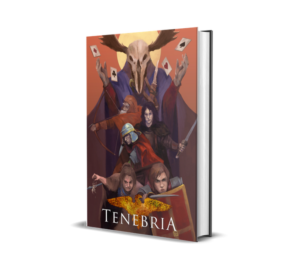 I want to thank Brandon, Matthew, and Charles for contributing their answers to this article. If you’re interested in following them, here’s their contact information and some of the items that they’re working on right now.
I want to thank Brandon, Matthew, and Charles for contributing their answers to this article. If you’re interested in following them, here’s their contact information and some of the items that they’re working on right now.
Brandon K. Aten and Matthew Orr from Wet Ink Games. Follow them on Facebook and Instagram (@WetInkGames) and at their Kickstarter for Tenebria: Remnant of Rome which ends on Saturday, September 21, 2019 at 9:00 PM EDT.
“Our next project is another game using the +One system, but this is a different historical setting. Tenebria: Remnant of Rome takes place after the fall of the Roman Empire and the players take on the roles of the last Romans trying to eke out an existence in their new home of Tenebria. It still uses the dice manipulation, but cards represent certain resources. They can still be used to level up your character, but they can also be used to improve your city so you all benefit as the stories play out. We’re really excited about this project and the fact that we get to work with the awesome writer and artist Steven Wu to bring it to life is just another treat. The book and art are complete, with the exception of anything we knock out as stretch goals, so we don’t think it is out of the question to have it delivered and in the hands of backers by the end of 2019!
While we have a few other things in the works that we announced at Gen Con, we’re also working on three new books for Never Going Home. On January 14th, we will be launching a campaign for three campaign guides which will provide a wealth of new material to both narrators and players, each covering a specific area, region or conflict. In addition to new Whisper paths, equipment, monsters, and character options, these books will have a wealth of history, new fiction, optional rules for Narrators and up to six (6) connected missions characters can run through! All illustrated with ALL NEW ART by Charles Fergusson-Avery. These books will be packed full of material for ALL players of Never Going Home. We intend to cover the Gallipoli campaign, the Russian Revolution, and conflicts in the North Sea, and if these go over well, there are a wealth of other options to explore.
These books are already in development and should be close to complete by the launch of the Kickstarter. It is the intent to have them delivered mid-summer and have them available at Gen Con 2020.”
Charles Ferguson-Avery. Follow Charles on Instagram (@charlie_fergusonavery).
“Big book. Can’t say much about it at the moment. I’m calling it ‘Project Cobblestone’ for now.”
If you’re enjoying the articles on d20 Radio, consider supporting their Patreon here. Egg Embry participates in the OneBookShelf Affiliate Program and Amazon Associates. These programs provide advertising fees by linking to DriveThruRPG.
Latest posts by Egg Embry (see all)
- New Gamemaster Month 2023 - January 20, 2023

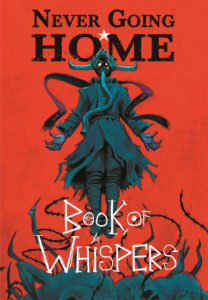
I was an early backer on this game (one of my friends was a stretch goal author, so I had to do my part to put him to work) and I really like what I read when the final product came out. Still a little unsure on how some things play out at the table. The Journey portion of the adventure seems really nebulous and not as well-defined as it could be, but I’m sure I just need to see it in action to get a feel for it.
Excited to read about the coming campaign guides though!
You are a good friend for helping put your friend to work! 😉
Journey portion may need something more. I’m in the same boat as you, I’d like to play through it long-term. 🙂